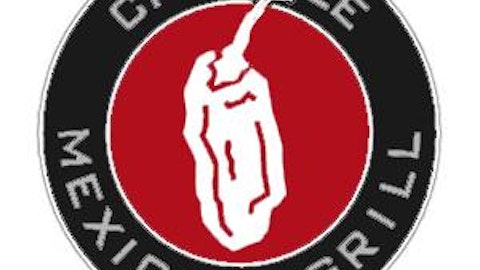Burger King Worldwide Inc (NYSE:BKW), the second largest hamburger chain in the world, recently surprised Wall Street with robust fourth quarter earnings that exceeded both top and bottom line estimates. While other fast food chains, such as McDonald’s Corporation (NYSE:MCD) and Yum! Brands, Inc. (NYSE:YUM), have struggled this past year attempting to balance global growth with unstable commodity costs and lagging demand, Burger King has apparently defied the odds and prospered.

Fourth Quarter Earnings
During the fourth quarter, Burger King reported adjusted earnings of 14 cents per share, or $48.6 million. Adjusting for one-time costs, earnings came in at 23 cents per share, topping the FactSet analyst consensus of 15 cents per share on the same basis.
Revenue came in at $404.5 million, also exceeding the forecast of $375.3 million. Although its bottom line more than tripled from a year earlier, when it was still privately held, its top line decreased 30% due to restructuring and refranchising costs.
Burger King finished fiscal 2012 with an EPS of 33 cents per share, or $117.7 million, up from 25 cents per share, or $88.1 million, a year earlier. However, revenue dropped 16% from $2.34 billion to $1.97 billion.
Lower costs and rapid growth
97% of Burger King’s restaurants are now franchised – up from 90% at the end of 2011. Restaurant chains traditionally shift towards a more franchise-centered business model because it collects royalties from franchisees, while minimizing its exposure to overhead costs and maintenance fees.
The franchisee model helped reduce Burger King’s costs substantially during the fourth quarter. Total operating costs fell 40% to $292.6 million, aided by lower expenses for food, packaging, rent and payroll.
The company used its stronger cash flow to renovate 600 restaurants in the United States and Canada, and hired more field managers to assist with its franchises. Burger King ended the quarter with 12,900 stores in 86 countries and territories.
Looking ahead, Burger King forecasts 3% food inflation in 2013, which will cause higher beef prices. However, it also expects declining prices for potatoes, cooking oil and paper packaging to more than offset those higher costs.
Specialty items boost sales
Burger King has also aggressively changed its menu to quickly meet shifting consumer tastes. Smaller chains such as Burger King and The Wendy’s Company (NASDAQ:WEN) can usually change their menus more often than larger chains such as McDonald’s or Yum Brands. During the quarter, Burger King’s North American sales were strengthened by strong sales of its chicken Paremsan sandwich, holiday gingerbread shares and Cinnabon Minibon rolls.
Value Menu
Analysts believe that the U.S. payroll tax increase in January will adversely impact discretionary spending across the board, even for fast food chains. As a result, industry growth is forecast to be flat to modestly up for fiscal 2013.
Therefore, analysts are concerned that Burger King’s Value Menu is not as comprehensive nor as competitively priced as offerings from McDonald’s or Wendy’s. In the fourth quarter, McDonald’s added a Grilled Onion Cheddar Burger to its Dollar Menu. Wendy’s added new items to its 99 cents menu, as well as a tiered pricing system that goes up to $2 per item.
Burger King’s management admitted that it had been focusing on its premium, higher margin products over cheaper ones. However, the company has acknowledged the need for cheaper menu items, and recently introduced a limited-time offer for a $1.28 Junior Whopper.
Same-Store Sales
Burger King also posted positive same-store sales in all global regions.
| Region | Year-on-Year Same Store Sales Growth |
| United States & Canada | 3.7% |
| Europe, the Middle East, Africa | 1.6% |
| Latin America | 0.7% |
| Asia Pacific | 0.8% |
| Total Global Growth | 2.7% |
Source: Quarterly Reports
In comparison, McDonald’s only posted 0.3% growth in the United States, along with a 1.7% decline in the Asia Pacific region and a 0.3% dip in Europe. McDonald’s total global same-store sales growth came in at an anemic 0.1% for the fourth quarter.
Sidestepping Scandals
Burger King also said it was not hurt by the recent beef scandal in Europe, where tests revealed manufacturers had been cutting costs by adding horse meat and pork to ground beef products.
The company was also unscathed by the chicken scandal in China, which revealed that Yum Brands’ KFC restaurants had been serving up hormone-injected chickens.
Versus Competitors
Although Burger King has only been trading since last June, we can still measure its stock performance against its larger rival McDonald’s and its smaller peer Wendy’s.
| Forward P/E | 5-year PEG | Price to Sales (ttm) | Debt to Equity | Profit Margin | |
| Burger King | 19.95 | 1.40 | 2.95 | 259.52 | 5.99% |
| McDonald’s | 17.53 | 1.82 | 3.41 | 95.53 | 19.82% |
| Wendy’s | 26.35 | 2.01 | 0.83 | 73.91 | 0.12% |
| Advantage | McDonald’s | Burger King | Wendy’s | Wendy’s | McDonald’s |
Source: Yahoo Finance
Fundamentally, Burger King doesn’t particularly shine in contrast to its primary competitors. It exhibits average growth rates for its industry as well as average margins. However, its massive debt-to-equity ratio sticks out like a sore thumb. Burger King currently has $546.7 million in cash but $3.05 billion in outstanding debt. While those numbers sound ominous, Burger King has aggressively reduced costs across the board, which should bring that ratio down in the future.
The Foolish Bottom Line
The new Burger King is fundamentally robust and exhibits strong same-stores sales growth across all geographic regions. The company’s shift towards an all-franchisee business model will cut costs and minimize downside risks. Lower costs in 2013, except for beef, could strengthen its margins further. A diverse, interesting menu has kept fast food customers in the United States interested in the restaurant, while hints of a cheaper value menu suggest a stronger competitive edge entering the next quarter. All of these factors suggest that Burger King could exhibit higher growth potential than its hamburger-making rivals McDonald’s and Wendy’s in 2013.
The article Can Burger King Claim the Crown in 2013? originally appeared on Fool.com and is written by Leo Sun.
Copyright © 1995 – 2013 The Motley Fool, LLC. All rights reserved. The Motley Fool has a disclosure policy.





